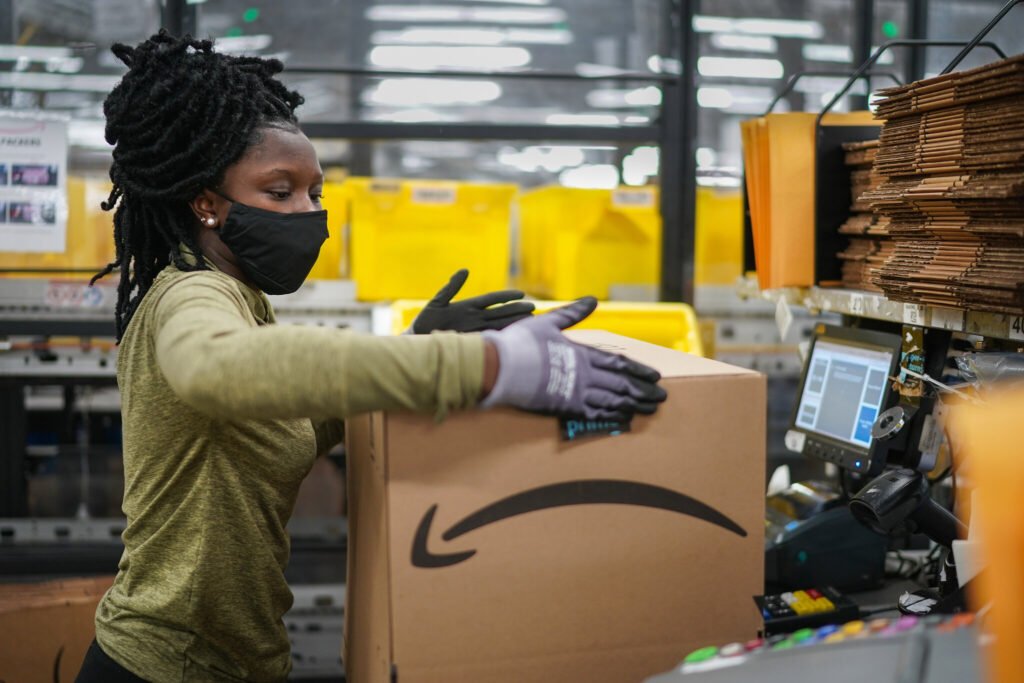When I visited an Amazon warehouse, I was amazed by how fast everything moved—robots zooming around and workers packing orders precisely. It felt like a well-oiled machine, and I could see how they ensured packages reached customers so quickly.
An Amazon warehouse is a large facility where products are stored, sorted, and shipped to customers. It plays a key role in Amazon’s fast delivery service, helping to process orders quickly. These warehouses use technology and automation to make the fulfilment process efficient.
Stay tuned with us as we explore everything you need to know about Amazon Warehouse. We’ll share tips on finding the best deals and how they work. Don’t miss out on how you can save big with Amazon Warehouse!
What Is Amazon Warehouse?
An Amazon warehouse is a large facility where products are stored, organized, and prepared for shipping to customers. When you order on Amazon, the items are picked from the warehouse, packed, and shipped. These warehouses are filled with thousands of products, from electronics to clothes.
Amazon uses advanced technology, like robots and automated systems, to speed up the process and make sure everything is in the right place. The goal is to get your order to you as quickly as possible, sometimes even the same day!
What Types Of Warehouses Does Amazon Operate?

Amazon operates several types of warehouses, each serving a specific purpose to support its vast fulfilment network:
- Fulfillment Centers: The main warehouses where products are stored, picked, packed, and shipped to customers.
- Sort Centers: Facilities where packages are sorted by destination before being sent to delivery stations.
- Prime Now Hubs: Focused on fulfilling same-day delivery orders for Amazon Prime members.
- Return Centers: Specialize in processing and managing returned items.
- Delivery Stations: Small hubs where packages are staged for last-mile delivery to customers.
How Are Products Stored In Amazon Warehouses?
In Amazon warehouses, products are stored using a “chaotic storage.” This means items aren’t kept in specific sections but are placed randomly based on available space. This approach helps maximize storage and speed up the retrieval process.
When an order is placed, Amazon’s system quickly locates the item, and workers or robots pick it from wherever it’s stored. Technology and algorithms ensure that everything is easy to find, even though it looks random. This method helps keep things efficient and allows Amazon to store millions of products.
Read: The Remarkable Legacy of Wunnyuruti Ziblim: A Deep Dive into His Creative Influence
What Types Of Products Are Stored In Amazon Warehouses?
| Product Type | Examples |
| Electronics | Laptops, smartphones, headphones, cameras |
| Clothing & Apparel | T-shirts, shoes, jackets, dresses |
| Books & Media | Novels, eBooks, movies, music CDs |
| Home & Kitchen | Furniture, appliances, cookware, bedding |
| Toys & Games | Board games, action figures, puzzles |
| Health & Beauty | Skincare, vitamins, personal care products |
| Sports & Outdoors | Exercise equipment, camping gear, bicycles |
| Food & Beverages | Snacks, pantry items, drinks, groceries |
| Automotive | Car accessories, tools, maintenance products |
| Office Supplies | Paper, pens, desks, printers |
How Many Amazon Warehouses Are There?
Amazon operates over 175 fulfilment centres worldwide, with many more distribution and sorting centres. These warehouses are strategically located in different regions to ensure fast delivery times to customers. Amazon keeps expanding its network to handle millions of products and orders daily.

The number of warehouses continues to grow as the company works to improve its shipping speed and reach more areas. These warehouses are crucial in helping Amazon meet the growing demand for quick deliveries.
What Role Do Robots Play In Amazon Warehouses?
Robots play a big role in Amazon warehouses by helping to transport products quickly and efficiently. They move items from one location to another, reducing workers’ time walking around. These robots bring products to human employees, who pick and pack them for shipping.
By automating tasks like transporting goods, robots help speed up the entire process, making it easier for Amazon to fulfil orders quickly. Robots also allow warehouses to operate smoothly and efficiently, handling millions of products daily.
Read: Diddy Affidavit 2024 – Truth Behind The Serious Allegations!
How Fast Can Amazon Ship Orders From Its Warehouses?
- Same-Day Shipping: Amazon can deliver orders within the same day, especially for Prime members in select areas.
- One-Day Shipping: Amazon offers one-day delivery to eligible locations for many items.
- Two-Day Shipping: Amazon’s standard shipping for Prime members typically guarantees delivery in two days.
- Expedited Shipping: Customers can choose faster shipping options, depending on availability.
- Regional Variations: Shipping speed may vary based on the warehouse location and the customer’s proximity.
What Is The Working Environment Like In Amazon Warehouses?
The working environment in Amazon warehouses is fast-paced and focused on efficiency. Employees are expected to meet performance targets, including quickly picking and packing orders to ensure timely delivery. The environment can be physically demanding, with workers on their feet for long hours and often required to lift heavy items.

Amazon uses technology like handheld devices and robots to assist employees in completing their tasks. While the company emphasizes safety and provides training, the work can sometimes feel intense due to high expectations. Despite this, many workers appreciate the competitive pay and benefits Amazon offers.
How Does Amazon Ensure Product Accuracy In Its Warehouses?
Amazon ensures product accuracy in its warehouses through a combination of technology and processes:
- Barcode Scanning: Workers and robots scan products at every stage to confirm that the correct item is being picked, packed, and shipped.
- Automated Systems: Amazon uses AI and machine learning algorithms to optimize inventory and reduce product picking and stocking errors.
- Quality Checks: Automated systems and workers perform final quality checks to verify product accuracy before shipping items.
- Real-Time Data: Continuous tracking and real-time updates allow Amazon to catch and correct mistakes quickly.
- Employee Training: Workers are trained to follow specific procedures to ensure accuracy throughout the fulfilment process.
Read: Fmybrainsout – Guide To Boosting Mental Performance!
How Does Amazon Handle Returns In Its Warehouses?
Amazon handles returns in its warehouses through a specialized process:
- Return Centers: When customers return products, the items are sent to Amazon’s return centres, which are dedicated facilities for processing returns.
- Inspection and Processing: Once the returned items arrive, they are inspected to determine if they are in a sellable condition. The returned products are either restocked in inventory, refurbished if necessary, or disposed of based on their condition.
- Restocking: If the item is in good condition, it may be available for resale. Items that can’t be resold might be returned to the manufacturer or donated.
- Refunds: Once the return is processed, customers are refunded, and the return is fully processed within Amazon’s system.
What Is The Difference Between A Fulfilment Centre And A Sorting Centre?

The difference between a fulfillment centre and a sorting centre lies in their specific roles within Amazon’s logistics network:
Fulfillment Center:
This is where products are stored, picked, packed, and shipped to customers. When an order is placed, the fulfilment centre is responsible for locating the items, packaging them, and preparing them for delivery. Fulfilment centres are typically larger and handle various products from start to finish, including inventory management.
Sort Center:
Once a package leaves a fulfilment centre, it may be sent to a sorting centre. Here, packages are sorted by their final delivery destinations and grouped accordingly. Sort centres play a crucial role in speeding up the shipping process by organizing packages based on geographic areas. This helps streamline the shipping process by organizing packages before they are sent to delivery stations for last-mile delivery to customers.
Read: Https://Fotise.Com/Cuanto-Dura-La-Aprobacion-Previa-De-La-Hipoteca/ – Must Know!
FAQs:
1. Do Amazon warehouses offer eco-friendly features?
Yes, many Amazon warehouses use renewable energy, energy-efficient lighting, and solar panels. Amazon is committed to reducing its carbon footprint and using sustainable practices. These efforts are part of Amazon’s goal to reach net-zero carbon emissions by 2040.
2. Can I work at an Amazon warehouse?
Yes, Amazon hires warehouse workers for a variety of roles. The company offers competitive wages, health benefits, and opportunities for career growth. Many workers start in entry-level positions but can advance with experience and training.
3. Do Amazon warehouses operate 24/7?
Yes, many Amazon warehouses operate around the clock to meet customer demand. The company runs multiple shifts daily to ensure fast processing and shipping.
4. How are large and bulky items handled in Amazon warehouses?
Large and bulky items, like furniture or large appliances, are stored in designated areas in Amazon warehouses. These items are handled with specialized equipment and may require special packing procedures to ensure safe delivery.
5. What is a “chaotic storage” system in Amazon warehouses?
In the chaotic storage system, products are stored randomly rather than in specific locations. This allows Amazon to use space more efficiently, and advanced technology helps track where each item is, making it easier to retrieve them quickly.
6. How does Amazon ensure employee safety in its warehouses?
Amazon warehouses have safety protocols, including proper training, equipment, and safety measures to prevent accidents. The company also uses technology to monitor warehouse conditions and improve worker safety.
Conclusion:
Amazon warehouses are essential to the company’s ability to offer fast and reliable delivery to customers worldwide. They store, pick, pack, and ship millions of products daily, using advanced technology and automation to increase efficiency.
With numerous fulfillment centres and specialized hubs, Amazon ensures customer orders are processed quickly and accurately. These warehouses play a crucial role in maintaining Amazon’s high customer service and satisfaction standards.
Read more:
- The Ultimate Guide to “teenthailand_11_sc1”
- Comprehensive Guide to “M6 AUC 4S0101”: Everything You Need to Know
- Bnsf Workforce Hub – Tips And Insights You Need!






